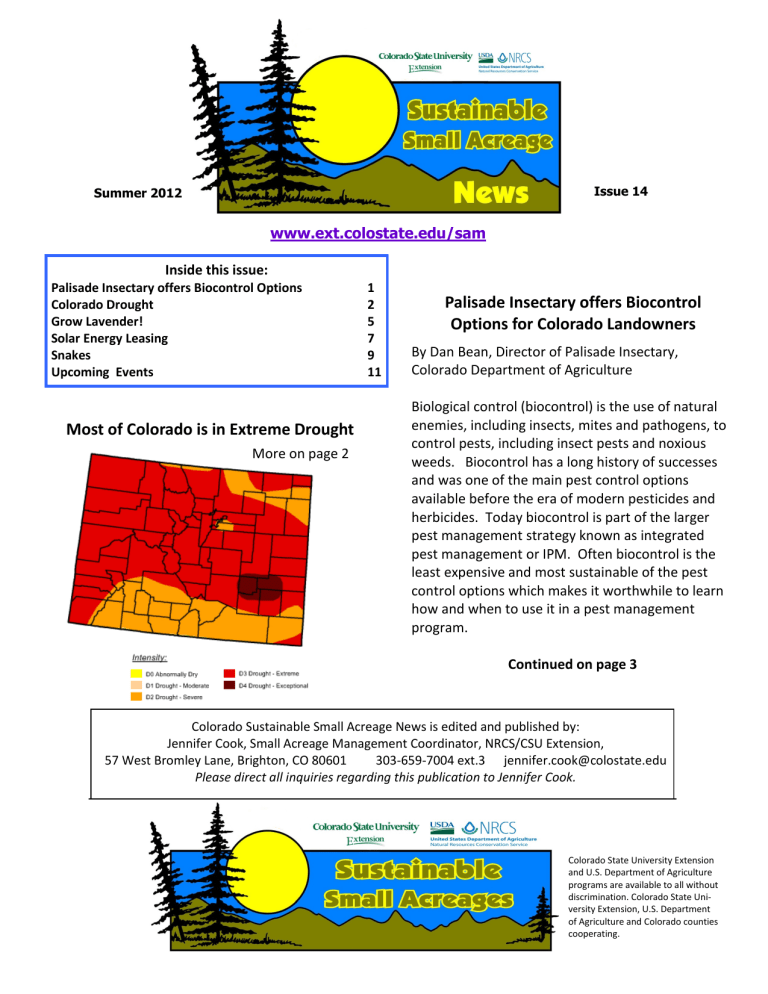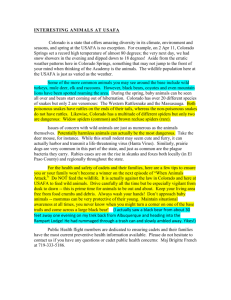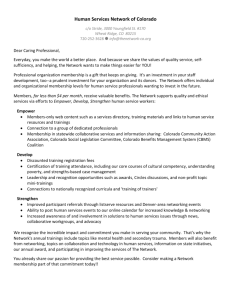Palisade Insectary offers Biocontrol Options for Colorado

Summer 2012 Issue 14 www.ext.colostate.edu/sam
Inside this issue:
Palisade Insectary offers Biocontrol Options
Colorado Drought
Grow Lavender!
Solar Energy Leasing
Snakes
Upcoming Events
Most of Colorado is in Extreme Drought
More on page 2
1
2
5
7
9
11
Palisade Insectary offers Biocontrol
Options for Colorado Landowners
By Dan Bean, Director of Palisade Insectary,
Colorado Department of Agriculture
Biological control (biocontrol) is the use of natural enemies, including insects, mites and pathogens, to control pests, including insect pests and noxious weeds. Biocontrol has a long history of successes and was one of the main pest control options available before the era of modern pesticides and herbicides. Today biocontrol is part of the larger pest management strategy known as integrated pest management or IPM. Often biocontrol is the least expensive and most sustainable of the pest control options which makes it worthwhile to learn how and when to use it in a pest management program.
Continued on page 3
Colorado Sustainable Small Acreage News is edited and published by:
Jennifer Cook, Small Acreage Management Coordinator, NRCS/CSU Extension,
57 West Bromley Lane, Brighton, CO 80601 303-659-7004 ext.3 jennifer.cook@colostate.edu
Please direct all inquiries regarding this publication to Jennifer Cook.
Colorado State University Extension and U.S. Department of Agriculture programs are available to all without discrimination. Colorado State University Extension, U.S. Department of Agriculture and Colorado counties cooperating.
Drought
Much of the US, including Colorado, is in an extreme drought. Drought affects the farming industry more than any because our dryland crops are dependent on mother nature to quench their thirst. A recent Drought Monitor report shows that
88% of US corn and 87% of US soybeans are impacted, which means food prices will rise as a result.
Colorado dryland pasture production is down 30-
40% in most places. If you are still allowing livestock to graze on a dryland pasture, the grasses will be damaged. If grasses exit a drought in poor condition, the road to recovery is much longer.
Here are a few tips to help your dryland pastures stay healthy through the drought:
Remove animals from pasture now!
Resist the urge to graze the rest of this year, even if we get some rain and grasses green up.
They will need the extra leaf area for photosynthesis to produce energy for the winter. During drought, grass plants rely on mature leaves to continue functioning.
The drought will affect next year’s forage production. If possible, do not graze at all next year to allow for grasses to fully recover. If you do allow grazing, delay spring turn-out by 2-4 weeks.
Control weeds this fall (if we get moisture) or next spring.
Fertilize next spring according to a soil test. Use a certified soil testing lab.
Always practice good pasture management.
Wait until grasses are 6-8 inches tall before grazing. Stop grazing when grasses are 3-4 inches tall.
For more on grazing management, check out the pasture section of CSU Extension Small Acreage
Management website at www.ext.colostate.edu/ sam/pasture.html
Other Drought Resources
CSU Extension drought related tip sheets available at http://www.ext.colostate.edu/drought/ droughttips.html
On this website, one can find tip sheets such as:
Nitrate Poisoning in Drought Stressed Forages
Determination of Soil Moisture
Efficient Landscape Irrigation during Drought and with Limited Water Availability in CO
Water Conservation in a Vegetable Garden
Woody Plant Management during Drought and with Limited Water Availability in CO
Impacts of Drought on Wildfire
To stay up to date on the Colorado’s climate, water, and drought assessment, visit the Colorado Climate
Center website at http://climate.colostate.edu/ drought_webinar.php
They offer a free webinar once a week to discuss the current weather conditions.
US Drought Monitor http://www.drought.unl.edu/ dm/monitor.html
National Drought Mitigation Center http://drought.unl.edu/ has info on drought planning, drought for kids, pasture during drought, etc.
Water Webinar Series
Learn more about water rights, drought,
Colorado climate, water use, irrigation, and water-wise turf grass. Registration links can be found under Hot topics at www.ext.colostate.edu/sam
2
Insectary offers Biocontrol continued from page 1
The most common questions about biocontrol are “Is it safe?” and “does it work?” The topic of safety will always be hotly debated. Biocontrol is by definition, the introduction of control agents into areas where they had not previously been, and the fear is that the biocontrol agents may attack something other than the targeted pest. During the modern era of biocontrol, starting in about 1970, biocontrol has had an excellent safety record. All pest control methods have some associated risks but under current guidelines the risks of biocontrol are quite small. This is because biocontrol practitioners have focused on finding agents that restrict their feeding to the targeted pest. These are called specialists, and they are the only type of agent that will be approved for open release by the USDA. For instance, if a weed is targeted for biocontrol, all potential agents that feed on the weed must be tested by allowing them access to hundreds of other plant species. If it appears that the agent will damage plants other than the weed, then it is not deemed a specialist, and will be dropped from consideration.
Not every biocontrol program provides sufficient control of the pest but the successes of some biocontrol programs have been spectacular. The first weed biocontrol program in North America involved the release of two beetle species against St. Johnswort,
Palisade Insectary and Greenhouse an introduced weed of rangelands. Following release of the beetles in the 1940s St. Johnswort has declined dramatically and in many parts of the west is no longer a problem. This freed up tens of thousands of acres of rangelands and the economic benefits are still accumulating nearly 70 years later. Closer to home, for nearly 70 years the Palisade Insectary has been growing and releasing a parasitic wasp, known as Mac, for the control of Oriental fruit moth (OFM) on peaches. Peach farmers have been saved the headache and expense of spraying for OFM, and the
Mac are supplied to them free of charge. In these two cases, as in all biological control programs, the targeted pest or weed was not eradicated but rather it decreased in abundance to the point of having far less negative economic impact.
Continued on page 4
Releasing tamarisk beetles
3
Palisade Insectary offers Biocontrol continued from page 3
The Palisade insectary is home to the Colorado Department of Agriculture’s Biological Pest Control
Program. The mission of the program is to provide biocontrol agents and expertise such that biocontrol is an economical and broadly utilized tool to manage pest problems throughout Colorado.
To help achieve this goal the Insectary rears and/or distributes about 20 species of biocontrol agents for use against weeds and insect pests. The Insectary also does extensive monitoring and evaluation of the biocontrol programs in order to provide information needed to farmers, ranchers, landowners and resource managers, which will allow them to effectively use biocontrol as a pest management strategy.
Some of the biocontrol agents currently being distributed and monitored by the Insectary include the field bindweed mite, the tamarisk beetle, and the Russian knapweed gall fly. The field bindweed mites have become well established throughout
Colorado and are causing field bindweed to decline on many properties. The impact of the mites will vary but they are recommended as part of a bindweed control program.
The tamarisk beetle was first released in Colorado in 2005 and is now widely distributed on the western slope and is becoming established in the Arkansas Basin. At some sites the beetles have defoliated trees multiple times and have killed up to 60% of the monitored trees. Beetles are still being redistributed and the long term impact of the insect on tamarisk is still being determined. It appears the beetle will be a valuable management tool.
The Russian knapweed gall fly was first introduced into Colorado in 2010. The fly feeds on the growing tips of Russian knapweed and stunts plant growth as well as reduces flowering. The Insectary is currently releasing and monitoring flies at selected sites in Colorado and will expand the program as the agents establish and become more widely
Using Bindweed Gall Mites to Control
Field Bindweed
Watch the short video on how to use bindweed gall mites to control field bindweed on your property. Watch at http://www.ext.colostate.edu/media/sm_acre/ index.html
available. Long term impact of the flies on knapweed will be determined through monitoring. This information will help determine how the flies should be used in a Russian knapweed control program.
Landowners who wish to use biocontrol should consider management goals and should see which agents are available. If the goal is complete eradication of a small infestation of a weed then biocontrol is not the best option. If the goal is to bring down the density of a weed, such as tamarisk or
Russian knapweed which will never be eradicated, then biocontrol might work for you.
Contact the Insectary to discuss the problem pest and we will let you know if biocontrol is a good option. For more information contact the Palisade Insectary at (970) 464-7916 or check out our website under Conservation Services, Colorado Department of Agriculture. http://www.colorado.gov/cs/
Satellite/Agriculture-Main/CDAG/1167928159775
4
Grow Lavender!
By Jennifer Cook, Small Acreage Management Coordinator, CSU Extension/NRCS
Lavender is a great option for land with minimal irrigation, and is a wonderful crop or landscape plant for Colorado. It is a semi-woody perennial sub
-shrub and a member of the mint ( Lamiaceae ) family. Lavender is used to make soaps, teas, baked goods, decorations, and it can be distilled to make essential oil, known for its medicinal and aromatherapy properties.
Originally a Mediterranean plant, two types of Lavender are hardy to Zone 5 and grow well in Colorado, English lavender ( Lavandula angustifolia ) and
Lavandin ( Lavandula x intermedia ) a hybrid of L. angustifolia and L. latifolia .
Among these two, there are many cultivars which have specific characteristics such as flower color, size, bloom time, and winter hardiness. Spanish and
French lavender are not cold hardy enough to survive Colorado’s winter, but can be used as annuals.
The calming aroma of Lavender was in the air when
I visited Prairie Wind Lavender Farm, a small acreage property in Strasburg, CO. Landowners Ingrid and Del planted about a quarter acre of lavender as a fun hobby and hope to eventually develop a small lavender business. We stood among the blooming lavender bushes while Ingrid explained, “We chose to plant a lot of the Munstead variety, knowing it was very winter hardy. Munstead are always blooming, making them harder than some varieties to harvest on a large scale. Ideally you can use a sickle and harvest the lavender bush all at one time.” We bent down to look at the blooms more closely as Del pointed out that the best time to harvest is just before full bloom. “After going to the
Lavender Festival in Palisade, we learned of other varieties with longer stems and more uniform bloom times” Ingrid added. They also learned that it’s better to buy plants that are grown from vegetative cuttings (clones), rather than from seed, so you know exactly what characteristics the plants will have.
Their rows are oriented on a south-facing slope, as lavender likes full sun and good drainage. Heavy
Lavender attracts lots of bees and butterflies. black fabric mulch keeps weeds from competing with the lavender bushes. Del tells me how he knows when to water the plants, “Stick your finger into the soil up to your second knuckle, if the soil is dry, it needs water.” Setting up a drip system is an easy way to water the plants. Once the plants are mature, they may only need to be watered every few weeks or so. “We are always amazed that they survive with the constant wind and dryness,” Ingrid comments, laughing. Lavender thrives in the sandy, alkaline soils and dry climate of Colorado.
As for yields, Del expects a few bundles per plant each year from their young plants, and up to 12 bundles per plant per year once the plants are larger and more established. Bundles generally contain 50-100 stems. Flowers form on new growth so
Continued on page 6
5
Lavender continued from page 5 prune lavender plants in the early spring when green leaves emerge from the base. Pruning will also keep the plants from getting too woody. Harvest in the morning when the oils are most concentrated. Tie each bundle with a rubber band and hang in a cool dark place to dry.
Dr. Curtis Swift is a CSU Extension horticulture agent in Grand Junction, where he is in the midst of many lavender trials. They are comparing winter hardiness and yields for multiple cultivars, and testing which types of frost barriers work best for winter protection. Another project is looking at how well lavender does in the shaded rows between grapevines. Swift also hopes to get a grant to study the specific components of lavender oils from various cultivars. If you would like to receive research results and other lavender growing information email CurtisESwift@gmail.com.
Rod Sharp, CSU Extension Agriculture and Business
Management Specialist, has developed a budget for lavender costs (establishment and maintenance expenses) and estimated revenues. Check it out at http://www.coopext.colostate.edu/TRA/PLANTS/
Lavender/Lavender%20production%20budget%
20in%20vineyard.pdf
For more information on growing Lavender:
Growing Lavender in Colorado, CSU Extension Fact
Sheet No. 7.245 http://www.ext.colostate.edu/pubs/ garden/07245.html
The Lavender Association of Western Colorado http://www.coloradolavender.org/
Lavender videos by Lavender at Stonegate in Oregon http://www.lavenderatstonegate.com/
Left: Young lavender plants grow in rows using black plastic mulch for weed control.
Top: Hanging lavender bundles dry for a few weeks before use.
6
Solar Energy Leasing
By Leigh Fortson, CSU Extension
There are lots of good reasons for Coloradans to consider installing solar panels on their homes given all those sunny days we brag about. Even so, there has been a significant obstacle that’s prevented many from obtaining a system. Expense. But here’s the good news: that’s changing!
My husband and I have wanted to install solar panels for years, but we just couldn’t find enough change under the living room couch to purchase the system. Even with tax breaks and other incentives, it just wasn’t feasible. Then we discovered the leasing option, and everything changed from there. Here’s how it works: There are likely hundreds of solar companies throughout the state that now have the capability of working with
PV system manufacturers and financing entities to offer solar leasing programs. We went with Syndicated
Solar (www.syndicatedsolar.com) a company that offers services in
Grand Junction and Denver. But there are many to choose from and it’s a good idea to find the company that best meets your needs.
First, Brad, a consultant from Syndicated Solar, came to our house to assess the physical property and make sure solar power was a good match for our home. With constant southern exposure and no trees in the way, we knew it would work well.
Brad then educated us about the difference between purchasing and leasing. For us it was a nobrainer. With no money down and only a $250 refundable deposit to Xcel to prove that we were serious, we chose the leasing option.
Since it was up to Syndicated to properly design and install the system, they spent several weeks determining the best way to proceed. We were given a mock-up of what the system would look like, how many panels would be required for our needs, and where the operational electric box would be located. We had to go through the typical credit check and overall financing approval for the panels because even though we weren’t going to own them, the leasing entity needed to know that we were going to make our lease payments rather than take an extended vacation in Hawaii. In turn,
Brad gave evidence of the solvency of the leasing company and the high quality of the panels. He provided pages of data backing up both and before long, both sides of this agreement were on board.
Our contract is easy to read and transparent. It explains everything in simple, readable terms, including the guarantee that we’ll pay $75 per month on our electricity for the next 20 years—no matter what happens with the market rate. This is a $20 decrease to our current electric costs. We’re pretty certain this rate will serve us well through the next two decades.
I asked Brad what he would suggest people do to ensure that they’re getting a good and reputable deal on a leasing option. His advice:
Ask for and call references, whether they’re residential or commercial, to get the inside scoop on the company and to find out if they followed through and made good on their promises.
Drive by any local systems that are already installed to make sure they’re aesthetically appealing.
Continued on page 8
7
Solar Energy Leasing continued from page 7
Do your own research online to be sure the proposed agreement is on par with what other companies are offering.
Be sure the agreement includes a guarantee from the leasing company (who owns the panels) that the system will hold up for the life of the agreement, and that they will repair or replace any panels that fail to do that.
Make sure the solar company uses master certified electricians to handle the electrical installations, and PV installers who are certified with the North American Board of Certified Energy
Practitioners.
Be sure that the leasing entity will cover, through their own insurance, any weather damage to the panels. (This points to the fact that your own homeowners insurance should not be increased by adding solar to your home). Our panels were designed to withstand hail the size of quarters and 60 mph winds. This is fine for where we live, but may not work for all of Colorado.
Watch for high penalty fees if you decide to sell your home. The system should be part of the overall sale of the house where the buyer can either continue leasing or buy the system outright.
Make sure your roof will not need to be replaced any time soon. Ask the consultant what it would cost to take the system down if there is a necessary repair.
Call your energy provider (i.e. Xcel) and make sure they’re partnering with solar companies to create these relationships. Whether you purchase or lease, you’ll still be on the grid and need buy-in from the power company. Not all of them are meeting their mandatory renewable energy requirements this way, so before you do anything else, check with them.
Solar technology is improving every day, and in another five years it will likely be superior to what we now have on our roof. That doesn’t matter. The panels we have are good for 40 years and we simply won’t need anything else. Plus we wanted to act now t o do what we could to reduce our carbon footprint and save money.
CSU Extension has created some invaluable calculation tools that can help determine whether purchasing a system is actually financially wise, and how long it will take to get a return on your investment.
You can also discern if leasing will really save you money (a solar consultant might promise that it will, but the solar calculator can confirm or contradict that promise). To access the Photovoltaic System
Calculator and the Solar Lease Financial Calculator, go to: http://www.ext.colostate.edu/energy/ solar.html
and look under CSU Resources.
8
S
District
nakes
By Megan Lowery, West Greeley Conservation
It would seem that snake sightings are on the rise this summer, but the snake population may not have changed all that much. So what’s the cause of so many snake encounters? It’s likely a result of the intense heat we have had this summer.
Warmer temperatures send these reptilian creatures in search for a cool place to rest.
Snakes are reptiles meaning, they have scales, lay eggs, and are ectothermic, meaning they rely on external sources to regulate their body temperature. However, rattlesnakes give birth to 5
-12 live young each about 10 inches or more in length. Snake skin is smooth and dry to the touch, and will often be shed more than once each year to accommodate a growing snake. Being ectothermic, snakes tend to avoid temperature extremes and prefer to hunt in mild climatic conditions. Snakes generally prey on small rodents, as well as bird eggs, nestlings, lizards, and insects.
There are 25 species of snakes in Colorado.
The western rattlesnake and the massasauga are the only venomous species in the state. The western rattlesnake is found in most habitats throughout the state while the massasauga is limited to grasslands in the southeastern portion of the state.
There are several ways in which to distinguish the rattlesnake from nonvenomous snakes, especially the bull snake which mimics the rattlesnake. The most distinguishing characteristic are the rattles on the tail; however, a rattlesnake may not rattle prior to striking thus it is important to be able to recognize other defining features. Venomous snakes will have fangs in addition to their rows of teeth. They also have facial pits between the nostrils and eyes. Venomous snakes have vertical or elliptical pupils that often look like thin lines in bright light whereas nonvenomous snakes have round pupils. Venomous snakes have a single row of scales between the vent and the tip of the tail while nonvenomous snakes have two rows of scales. Finally, venomous snakes have a broad triangular head and a narrow neck.
So how do you discourage these slithery creatures from invading your yard and home? Eliminate cool, damp places where snakes can hide, meaning remove brush and rock piles, keep shrubbery away from foundations, and cut tall grass. If you have a rodent or insect problem, then control these as
Source: http://www.venombyte.com/venom/snakes/western_massasauga.asp
Western massasauga they are an easy food source for snakes. It is also important to store grains in tightly sealed containers and clean up pet food. Seal all openings in your home or other buildings in order to prevent snakes from entering basements and crawl spaces.
Check for holes and
Continued on page 10
9
Snakes continued from page 9 cracks around doors, windows, water pipes, electrical lines, and any other entrances into your home. In areas with high concentrations, you may wish to construct a snake-proof fence around your yard or home (see Cerato and Andelt 2006 for more information on how to construct a snake-proof fence).
If you live or work in areas inhabited by rattlesnakes, it is important to be prepared for snake encounters. In general, rattlesnakes are nonaggressive unless startled, cornered, or stepped on. One should wear long, loose pants and calf-high leather boots or snake guards when in rattlesnake country. Do not jump over logs, turn over rocks, stick your hands in rock crevices, or sit on the ground without first checking for snakes. If you encounter a rattlesnake, remain calm and still, then slowly back away from the startled creature. If you encounter a dead rattlesnake, leave it alone as a dead rattlesnake can still bite and inject its venom.
This is because the snake’s heat sensory pits remain active until rigor mortis is complete.
If you are bitten by a rattlesnake, it is important to remain calm. Becoming overwrought will increase heart rate in turn increasing your circulation which will hasten the spread of the venom. Additionally, venomous snakes do not always release venom when they bite. Check the injured area immediately for one or two fang marks. Symptoms to a venomous snake bite are fairly quick and include pain and swelling in the injured area, followed by black and blue discoloration, and possibly nausea.
Depending on the location of the bite, on the leg or arm, there may be painful swelling of the lymph nodes in the groin or armpit respectively. When bitten by a venomous snake, one should get to a hospital immediately and if possible call ahead to the hospital.
Some first aid tips prior to reaching a hospital include: remove anything that may cause swelling below the bite area (i.e. jewelry, shoes, tight clothing), wash the wound with soap and water, and immobilize the bite area, keeping it in a neutral position below the heart. When bitten do NOT do the following: use a tourniquet, make an incision at the bite site, suck out the venom with your mouth, or pack with ice. Rattlesnake bites are relatively common and the hospital will have the needed antidote so stay calm.
Many of these tips can also be applied to your fourlegged friends as well. But it is also important to keep your pets on leash or keep them close in rattlesnake country as the inquisitive nature of dogs often leads to a rattlesnake bite. If your pet is bitten, then get them to a veterinarian as soon as possible.
Source: Cerato, M. and W.F. Andelt. 2006. Coping with Snakes. Colorado State University Extension.
Fact Sheet No. 6.501. http:// www.ext.colostate.edu/pubs/natres/06501.pdf
.
Source: http://www.californiaherps.com/snakes/pages/c.atrox.html
Western diamondback rattlesnake in typical defense posture.
10
Webinar: Understanding Colorado Drought
August 2, 2012 from 12:00 to 1:00 pm MT
Nolan Doesken, Colorado State Climatologist, will provide the most up to date information on the drought situation in
Colorado and what to expect for the remainder of the summer and future years. He will also discuss Colorado climate and drought trends.
To register go to https://docs.google.com/spreadsheet/ viewform?
formkey=dGJhYk1nSElTQklOdmtxcGZBdmxjMUE6MQ#gid=
0
Webinar: Raspberries for Colorado below 7000’
August 3, 2012 from Noon to 1:00 pm MT
A webinar is an online seminar. You can participate from any computer with internet access.
This free one hour webinar will cover the basics of raspberry growing in Colorado. Of all the berries, raspberries are the group that Coloradans are likely to have the most success with. Learn how to select the right varieties for you, how to prune and irrigate your raspberries and what pests and diseases to watch out for. To register go to https:// docs.google.com/spreadsheet/viewform?
formkey=dEExRllTYVhsZG9keDQtMW9MZGZfc0E6MQ#gid=
0
Ag Tours
August 7 (5:30-8:30 pm)
Longmont, CO
Please join us for these fun and informative tours of county owned agricultural land. We will visit 3 farms: crop production, livestock production and market farm on each tour.
All Tuesday tours will be from 5:30 pm to 8:30 pm. (Check-
In at 5:15 pm, buses leave at 5:30 pm)
Tuesday, August 7
Tuesday, September 11
Saturday, October 13 (1pm to 4 pm, Check-In at 12:45 pm)
Registration is Available NOW at www.2012agtours.eventbrite.com
Cost is $5 per participant/tour.
All tours will leave from Boulder County Fairgrounds in
Longmont unless otherwise stated.
Questions: please email agriculture@bouldercounty.org
Grass Tour
August 9 and 10, 2012 (8 am-5 pm)
Greeley, CO
This educational event covers the spectrum from establishing grass to management practices for long-term success.
Observe the successes and failures of grass sites in Weld
County. Join discussions revolving around the challenges that our arid climate, weeds, and grazing presents. To register: 970-356-7002 or 1-800-782-5947, info@pawneebuttesseed.com
Day 1:
Grass seed production,
CRP native grass establishment, and
Converting irrigated crop land to native grass
Day 2:
Small acreage grass establishment
Irrigation water management
NRCS grass and pollinator plots
Seed cleaning and production
Management intensive grazing
Hay production
Just Canning, The Basics
August 11, 2012 (10:00 am - noon)
Littleton, CO
Learn all about the how and why of canning food at home.
The workshop focuses on canning safety, types of equipment and proper canning methods for both the boiling water bath and pressure canner. *A great class for beginners and those needing a review. Price includes a free pressure canner dial gauge test (a $10 value), so bring you pressure canner lid or dial gauge if you have one. To register, please contact: Sheila Gains, Arapahoe County Extension, 303-730-
1920 or sgains@co.arapahoe.co.us.
Webinar: Blueberries for Colorado Gardens
August 13, 2012 from Noon to 1:00 pm MT
A webinar is an online seminar. You can participate from any computer with internet access.
This free one hour webinar will cover what you need to know to grow blueberries successfully in your garden. Blueberries have long been considered an impossible-to-grow garden delicacy in Colorado, but no more. You will learn what the major obstacles have been, and how to overcome them. Basic planting and irrigation instructions will be provided. To register go to https://docs.google.com/ spreadsheet/viewform?
formkey=dDVZendtTmgwNnBjbTZwMC10QUpraWc6MQ#gi d=0
11
Webinar: Colorado Water 101 for Small Acreage Landowners
August 15, 2012 from 12:00 to 1:00 pm MT
Join Colorado State University Extension for a 1-hour webinar to discuss the basics of water administration, urban versus agricultural water uses, and water quality implications.
Presented by Denis Reich, Water Resource Specialist, Colorado State University Extension.
To register go to https://docs.google.com/spreadsheet/ viewform?
formkey=dFdCc243ekw0dVlwM0h6bHZ6bjU4eWc6MQ#gid
=0
Webinar: Water Wise Landscapes on Small Acreages
August 23, 2012 from 12:00 to 1:00 pm MT
In this webinar, you will learn about plant selection and turf grass species for our dry climate. We will also discuss water conservation tips for your landscape. Presented by Robert
Cox, Arapahoe County CSU Extension Horticulture Agent.
To register go to https://docs.google.com/spreadsheet/ viewform?
formkey=dFVaWjRxTjd1VkNPNjlHYnV6WVFodnc6MQ#gid=0
Fermenting Foods
August 25, 2012 (10:00 am – 12:30 pm) in Longmont, CO
August 30, 2012 (6:00 – 8:30 pm) in Littleton, CO
Ever wonder if you could make your own, yogurt, sauerkraut, kim chi or ginger ale? If so, this class is for you. Natural fermentation is one of the oldest means of food preservation. Learn the science behind these products. Taste test and go home with directions and recipes to try it at home.
Class includes making and taking a small jar of kraut to ferment at home. To register please contact: Anne Zander,
Boulder County Extension, 303-678-6238 or azander@bouldercounty.org
Webinar: Apples for Colorado below 7000’
August 31, 2012 from Noon to 1:00 pm MT
A webinar is an online seminar. You can participate from any computer with internet access.
This free one hour webinar will give you the essential tools to have success with apples in most areas of our state. Of all the tree fruits, apples are the one that Colorado gardeners are likely to have the most success with. You will learn how to select the right varieties, the importance of choosing the right rootstock and how to manage the top insect and disease pests of this crop. To register go to https:// docs.google.com/spreadsheet/viewform?
formkey=dFdXNGZSeWV0Z0laVVBwcGt0ZEtSNXc6MQ#gid=
0
DIY Energy Assessment Workshops
September 8, 2012
Jefferson County Extension Office
Golden, CO
September 22, 2012
Business Incubator Center
Grand Junction, CO
October 13, 2012
Sangre de Cristo Electric Association
Buena Vista, CO
Workshops to help you assess whether your home is a good candidate for energy efficiency improvements, solar energy, and/or wind energy! Contact Cary.weiner@colostate.edu for more info.
Mastering High Altitude Cooking
November 10, 2012 (10:30 am – noon)
Littleton, CO
Preparing food at high altitudes requires some special considerations. Have your questions answered and baking, cooking and candy making dilemmas solved. Just in the time for holiday baking. Includes CSU Extension-tested high altitude recipes and tips for modifying your family favorites. To register, please contact: Sheila Gains, Arapahoe County Extension, 303-730-1920 or sgains@co.arapahoe.co.us.
For an updated list of events, visit CSU Extension
Small Acreage Management website www.ext.colostate.edu/sam/
Colorado State University Extension and U.S. Department of Agriculture programs are available to all without discrimination. Colorado State
University Extension, U.S. Department of Agriculture and Colorado counties cooperating.
12








